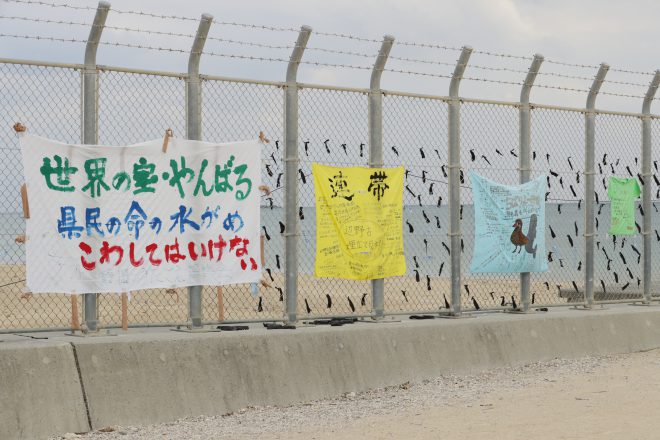Okinawa to sue Japan gov’t to block Futenma relocation
May 30, 2017
NAHA, OKINAWA PREF.- The Okinawa prefectural government is set to sue the Japanese government possibly in July to block landfill work related to the planned relocation of the U.S. Marine Corps' Futenma air base in the southernmost Japan prefecture, it was learned Tuesday.
The move will bring the two sides into a legal battle again over the landfill work at the Henoko coastal area in the city of Nago, Okinawa, the planned site for a new facility to take over the functions of the Futenma base, now in a congested area in the city of Ginowan in the same prefecture.
The Okinawa side claims that the central government has been conducting the reclamation work without filing for the renewal of prefecture's permission for crushing rocks and reefs off Henoko.
The local government plans to submit a relevant proposal to an Okinawa prefectural assembly session starting in mid-June, and file the lawsuit against the state after obtaining approval from the assembly, informed sources said.
It also plans to seek a provisional court injunction to suspend the landfill work, the sources said.
The central government on April 25 initiated the foundation work for protection walls around the landfill site, with stones dropped onto the seabed there.
While the state government has judged that there is no need to seek the renewal of the prefectural permission for destroying rocks and reefs, the Okinawa government has urged the Defense Ministry's Okinawa Defense Bureau in writing to obtain such permission.
"We're waiting for a reply from the bureau," Okinawa Governor Takeshi Onaga, a staunch opponent of the base relocation within the prefecture, told reporters in the Okinawa capital of Naha on Tuesday.
In December last year, the Supreme Court made a judgment that finalized the central government's victory in a lawsuit filed over Onaga's cancellation in 2015 of a permit for landfill at Henoko, which was given by his predecessor, Hirokazu Nakaima, in 2013. The top court concluded that there was no illegality in Nakaima's decision to approve the landfill.
The 10 cites were chosen under criteria including expected increases in the number of visitors and the likelihood of noticeable scenery improvement.
For example, the ministry picked Hirosaki because of the municipal government's plan to improve views of Mount Iwaki, the symbol of the locality. The city office plans to demolish old buildings in the central part of Hirosaki and create a spacious open area to create mountain views from many more places in the city.
The Tsuruga municipal government plans to rebuild old houses that stood in the city in the 1912-1926 Taisho period and enlarge pavements along the main road so that tourists can sit on benches to eat and talk.
With the Hokuriku Shinkansen high-speed train line set to be extended to Tsuruga by the end of March 2023, the municipal government there will seek to improve the attractiveness of the city as a tourist destination.
The ministry launched the "second Kyoto" program to contribute to the government's plan to increase the annual number of foreign visitors to Japan to 40 million by 2020. While record-breaking numbers of tourists from abroad are visiting Japan, they often limit their stays to Tokyo, Osaka and other big cities.
For fiscal 2017, which ends in March 2018, the ministry has earmarked a budget of 2.5 billion yen to provide subsidies to cover half of construction expenses under the program in the 10 cities. It plans to set aside annual outlays at least as large to continue support for scenery improvement projects through fiscal 2019.
"The 10 cities should change so much that after three years visitors will be surprised and wonder where they are," said a ministry official involved in the program. (Jiji Press)
Latest Videos
- THE UNTOLD STORY EXPERT INSIGHTS INTO THE UKRAINE
- NEGOTIATING A NEW ORDER US RUSSIA TALKS ON UKRAIN
- Ukraine: A Pawn in the Geopolitical Game? Will Trump Intervene?
- US VP VANCE CRITICIZES EUROPEAN DEMOCRACIES AT MUNICH SECURITY CONFERENCE
- UNCOVERING THE WEB OF DECEIT: CIA INFILTRATION OF THE MEDIA
- SHIFTING SANDS: TULSI GABBARD’S CONFIRMATION AND THE EVOLVING GLOBAL LANDSCAPE
- FAUCI SCANDAL: A THREAT TO GLOBAL HEALTH AND DEMOCRACY






